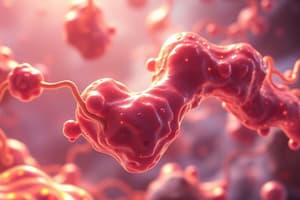Podcast
Questions and Answers
Which statement about lipoproteins is correct? (Select all that apply)
Which statement about lipoproteins is correct? (Select all that apply)
- Exogenous lipid transport pathway ensures TAGs utilization from muscles and adipocytes (correct)
- Chylomicrons are involved in the endogenous transport pathway of lipoproteins (correct)
- ApoA1 is necessary for the elimination of cholesterol from peripheral tissue (correct)
- TAGs are a major component of LDL particle
Which statement about the carnitine-acylcarnitine shuttle is correct? (Select all that apply)
Which statement about the carnitine-acylcarnitine shuttle is correct? (Select all that apply)
- Translocase ensures carnitine transport in the mitochondrial matrix (correct)
- This shuttle ensures the transport of TAGs in the cells
- Carnitine can be derived from food and synthesized in the liver (correct)
- Genetic mutations in enzymes of this system would lead to weight loss
Which statement about the oxidation of fatty acids is correct? (Select all that apply)
Which statement about the oxidation of fatty acids is correct? (Select all that apply)
- Beta oxidation occurs only in the liver, skeletal muscle, adipocytes, and heart
- Beta-oxidation occurs in mitochondria and peroxisomes (correct)
- Fatty acids for oxidation are mobilized from lipid droplets in adipose cells covered with albumin (correct)
- Alpha oxidation eliminates the methyl group at a carbon atom
Which statement about ketogenesis is correct? (Select all that apply)
Which statement about ketogenesis is correct? (Select all that apply)
Which statement about fatty acid biosynthesis is correct? (Select all that apply)
Which statement about fatty acid biosynthesis is correct? (Select all that apply)
Which statement about the biosynthesis of triacylglycerides is correct? (Select all that apply)
Which statement about the biosynthesis of triacylglycerides is correct? (Select all that apply)
Which statement about cholesterol biosynthesis is correct? (Select all that apply)
Which statement about cholesterol biosynthesis is correct? (Select all that apply)
Which statement about glycerol metabolism is correct? (Select all that apply)
Which statement about glycerol metabolism is correct? (Select all that apply)
Which statement about amino acid synthesis is correct? (Select all that apply)
Which statement about amino acid synthesis is correct? (Select all that apply)
Which statement about transamination is correct? (Select all that apply)
Which statement about transamination is correct? (Select all that apply)
Which statement about deamination is correct? (Select all that apply)
Which statement about deamination is correct? (Select all that apply)
Which statement about the urea cycle is correct? (Select all that apply)
Which statement about the urea cycle is correct? (Select all that apply)
Which statement about glucose-alanine cycle is correct? (Select all that apply)
Which statement about glucose-alanine cycle is correct? (Select all that apply)
Which statement about purine metabolism is correct? (Select all that apply)
Which statement about purine metabolism is correct? (Select all that apply)
Flashcards are hidden until you start studying
Study Notes
Lipoproteins
- ApoA1 is crucial for removing cholesterol from peripheral tissues.
- Chylomicrons play a role in the exogenous transport pathway of lipoproteins.
- TAGs are a major component of LDL particles.
- The exogenous lipid transport pathway ensures the utilization of TAGs from muscles and adipocytes.
Carnitine-acylcarnitine Shuttle
- This shuttle facilitates the transport of fatty acids into the mitochondria to be broken down for energy.
- Translocase facilitates carnitine transport into the mitochondrial matrix.
- Genetic mutations affecting enzymes in this system can lead to problems with fat metabolism, not weight loss.
- Carnitine can be obtained through diet and is also synthesized in the liver.
Fatty Acid Oxidation
- Alpha oxidation removes a single carbon atom from a fatty acid chain, typically removes methyl group.
- Beta-oxidation takes place in both mitochondria and peroxisomes.
- This process occurs not only in the liver, but also in skeletal muscle, adipocytes, and the heart.
- Fatty acids are mobilized from lipid droplets in adipocytes by binding to albumin for transport.
Ketogenesis
- Elevated levels of insulin actually suppress ketogenesis.
- Beta-hydroxybutyrate is the most common ketone body produced in the human body, not acetone.
- The process occurs primarily in the mitochondria of liver cells.
- Acetyl-CoA, produced from the breakdown of fatty acids in adipocytes, serves as the substrate for ketone body synthesis.
Fatty Acid Biosynthesis
- The substrate acetyl-CoA is derived primarily from carbohydrate metabolism, not beta-oxidation.
- Most cells can synthesize fatty acids, but the process primarily takes place in the cytoplasm, not the mitochondria.
- The pentose phosphate pathway provides the reducing power (NADPH) required for fatty acid biosynthesis.
- Fatty acids with more than 18 carbons are synthesized in peroxisomes.
Triacylglyceride Biosynthesis
- TAGs are primarily stored in adipose tissue, not every cell.
- Acyltransferases are key enzymes involved in the synthesis of TAGs.
- TAGs are synthesized in the cytoplasm, not the mitochondrial matrix.
- TAGs have a glycerol backbone with three fatty acid chains attached.
Cholesterol Biosynthesis
- HMG-CoA reductase, not lyase, is the rate-limiting enzyme of cholesterol synthesis.
- Cholesterol synthesis is primarily active during the fed state.
- Cholesterol is essential for synthesizing steroid hormones, not peptide hormones.
- Most of the cholesterol comes from endogenous synthesis, not diet.
Glycerol Metabolism
- Glycerol is converted to glycerol-3-phosphate by glycerol kinase, not dehydrogenase.
- Glyceroneogenesis can occur in the liver, kidneys, and adipose tissue, not just the liver and kidneys.
- Glycerol-3-phosphate is mainly formed from dihydroxyacetone phosphate (DHAP), an intermediate in glycolysis.
- Alanine is formed from pyruvate, not glycerol, in the process of transamination.
Amino Acid Synthesis
- Glutamate is the primary donor of amino groups for synthesizing new amino acids.
- Amino acid synthesis is more active during the well-nourished state, not during fasting.
- Essential amino acids cannot be synthesized by the body and must be obtained through diet.
- The synthesis of amino acids primarily occurs in the cytoplasm.
Transamination
- It primarily occurs in the cytosol.
- ALT levels in the blood increase in the case of liver damage, not after intensive workouts.
- Alpha-ketoglutarate, not oxaloacetate, is the most common amino group acceptor.
- Transamination plays a crucial role in both amino acid synthesis and catabolism.
Deamination
- Glutamate is the typical substrate for deamination reactions.
- Deamination is not limited to tissues involved in urea production, occurring wherever amino acids are metabolized for energy.
- The amino group is removed and converted to ammonia, not transferred to another molecule.
- It is essential for eliminating waste products from amino acid breakdown for energy production.
Urea Cycle
- The reactions of the urea cycle occur in both the mitochondria and the cytosol.
- It primarily takes place in the liver, not all cells.
- In case of liver failure, the urea level in the bloodstream will decrease, not increase, due to the liver's inability to excrete it.
- The fifth reaction of the urea cycle is the synthesis of arginine, not transamination.
Glucose-alanine Cycle
- It describes the transfer of amino groups between muscle tissue and the liver, not the brain and the liver.
- It involves gluconeogenesis in the liver, which ensures energy for muscle tissues.
- The cycle includes deamination reaction in the muscle.
- Alanine is synthesized from pyruvate in the muscle, not directly from glucose.
Purine Metabolism
- Uric acid formation releases ammonia and not ammonium.
- The primary form of nitrogen excreted from the human body is urea, not uric acid.
- The breakdown of purines results in the common intermediate xanthine.
- Inositol is not involved in purine catabolism.
Studying That Suits You
Use AI to generate personalized quizzes and flashcards to suit your learning preferences.





